We were fortunate to see three species of dwarf antelopes on our recent trip to Kruger National Park. For an idea of their size, they stand no more than about 60 cm (23.5 in) tall at the shoulder and the average weight of individuals is in the region of 8–13 kg (17.5–28.5 lbs).
Traditionally 13 species of dwarf antelope are classed as members of the Neotragini tribe (part of the Antilopinae subfamily). Three of these species occur in the Kruger National Park – steenbok, Sharpe’s grysbok and klipspringer. Historically, a fourth species, being oribi antelope, used to occur in a section of the park (Pretoriuskop region), but changes in habitat led to their disappearance, and subsequent attempts at reintroduction failed. Suni is another species of dwarf antelope that is sometimes reported as being in the park, but this was due to the introduction of captive-bred animals in the 1990s, but after three years it was found that none of these individuals survived (information from the KrugerExplorer App).
Steenbok (Raphicerus campestris)

Of the three dwarf antelope that currently occur in the park, the steenbok is the most widespread and numerous, although not always easy to see (as illustrated in the above photo). They commonly occur in lightly-wooded grassland where they browse on the leaves of small plants and trees, though they may occasionally eat fruit and the tops of fresh young grasses when available. They may also dig up edible tubers.

As in most dwarf antelopes, only the male has horns. Steenbok are largely diurnal and individuals forage on their own even when part of a stable and monogamous breeding pair. Territorial pairs stay in touch through scent marking – the male marks vegetation using pre-orbital glands, and both sexes maintain territorial dung-middens connected by trails. When using the middens, both sexes paw at the ground and scent-glands on the underside of the feet will leave a trail of scent both at the middens and on the pathways linking the middens. This pawing the ground before, during and after defecating at middens may have the effect of partially covering the dung rather than steenbok actively burying the dung as is sometimes described.

Above is a female steenbok showing the large ears and the patterns in the fur inside the ears. Steenbok mothers give birth to one baby that is able to stand and walk within five minutes; however babies remain hidden for about two weeks or even longer before they start following their mothers. Young steenbok are suckled until they are about 3 months old.
Sharpe’s grysbok (Raphicerus sharpie)

In the Kruger National Park another dwarf antelope, the relatively rare Sharpe’s grysbok, is more likely to occur in denser bush in rocky terrain, particularly in the northern and eastern regions of Kruger National Park, such as around the Punda Maria Rest Camp. It is estimated that there are only about 300 Sharpe’s grysbok in the whole of the Kruger National Park.
During our visit, while on a morning game drive around Punda Maria I announced rather flippantly that I wanted to see a Sharpe’s Grysbok that morning. Imagine our surprise when not long after my saying that we actually did! A female Sharpe’s grysbok was browsing on low bushes and branches near the gravel road – we almost didn’t see her as it was easy to miss her in amongst the vegetation. No wonder sightings of these usually secretive little antelope are uncommon, but there she was as shown in the photo above.

Rather than being secretive, this grysbok appeared to ignore us and continued browsing with determination. (We thought she looked pregnant and if so, she was of course eating for two!) Grysbok are mostly nocturnal, but on an overcast day this female was active even during the late morning. The diet of the Sharpe’s grysbok, as for the steenbok, in addition to browsing leaves may occasionally include fruits, fresh grass shoots and edible tubers and roots that they dig up using their hooves.

The grey/white speckling in the fur is what gives the grysbok its name, as ‘grys’ means grey. The Sharpe’s grysbok is thought to be mostly solitary although, like the steenbok, even though they may forage alone, it is likely that they too form stable breeding pairs and share in defending territory. So in addition to solitary individuals, adult pairs or females accompanied by their young are sometimes seen. Females give birth to one or two babies, and breeding is annual.

As they are mostly nocturnal, usually Sharpe’s grysbok rest during the day and they are known to shelter in rocky crevices and even use old aardvark burrows as protection from predators. Like other dwarf antelope species they mark their territory with dung middens and scent-mark vegetation with their pre-orbital glands.
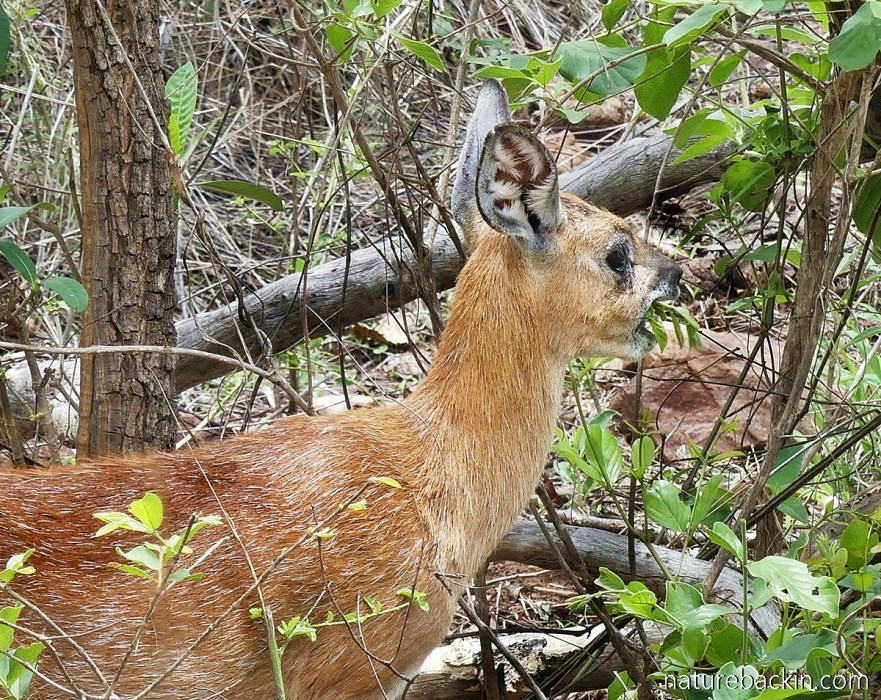
We felt very privileged to be able to watch this little antelope at fairly close quarters for about ten minutes before she slowly moved off into thicker vegetation. She was alert and aware of our presence but remained calm and confident despite the reputation for shyness.

It surprised me when I first learnt that antelopes, including the dwarf antelopes, are classed in the Bovidae family, which also includes cattle, sheep and goats. All Bovidae species are ruminants where the males (and for many species the females too) have unbranched horns. Although antelope and deer are sometimes confused as being the same, antelope have unbranched horns that are not shed and deer have antlers that are shed and regrown each year (and so deer species are not classed as Bovidae). There is only one species of naturally occurring deer in Africa, and that is the Barbary stag (Cervus elaphus barbarus) found only in the in the north of Africa, for example in the Atlas Mountains.
Incidentally, the North American pronghorn (Antilocapra americana) is not a true antelope and is not classed among the Bovidae species. It sheds the keratin sheath on its horns annually, and the horns are branched – or at least forked – with a smaller forward-pointing ‘prong’. The pronghorn is classed on its own as the only extant species in the genus Antilocapra, which in turn is the only genus in the family Antilocapridae. Interestingly, the pronghorn is more closely related to the giraffe family than it is to the bovid family.
Klipspringer (Oreotragus oreotragus)

While driving through a region of the Kruger National Park punctured with with rocky outcrops strewn with large boulders we kept our eyes open for klipspringers – the name in Afrikaans/Dutch literally means ‘rock jumpers’. We were thrilled to see a male klipspringer standing on guard on a high rocky vantage point. As can be seen in the above photo he resembles a rather strategically placed statue.
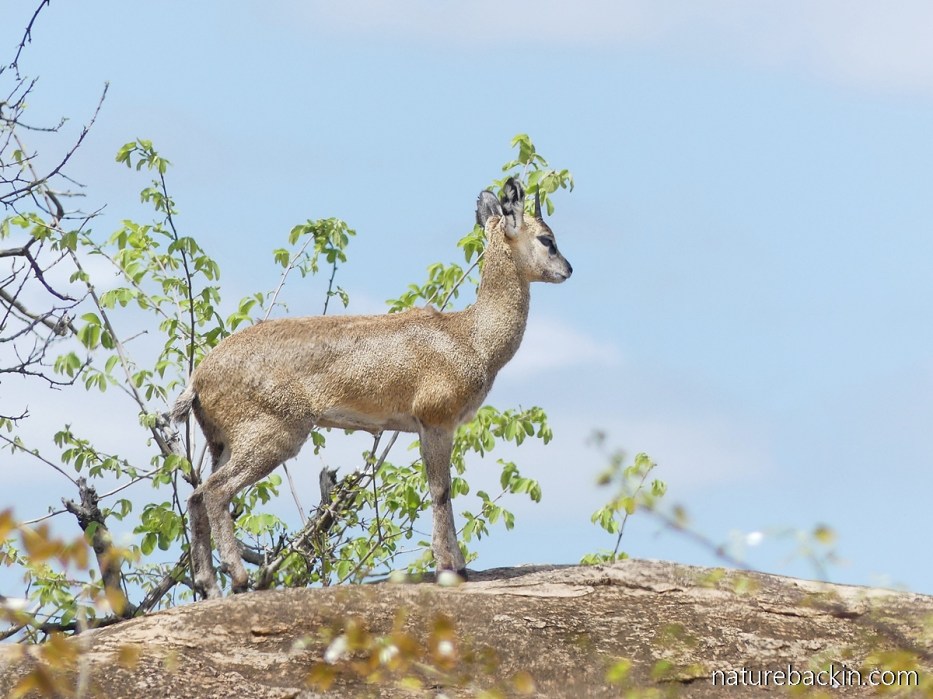
Above is a closer look at the same male klipspringer, standing stock still apart from the occasionally twitching leg in response to an itch, and sometimes chewing the cud.
In a breeding pair the male stands lookout for much of the day playing a watchdog role while the female is able to spend more time foraging or perhaps attending to a baby, which she suckles twice a day until the baby is weaned at 4-5 months.
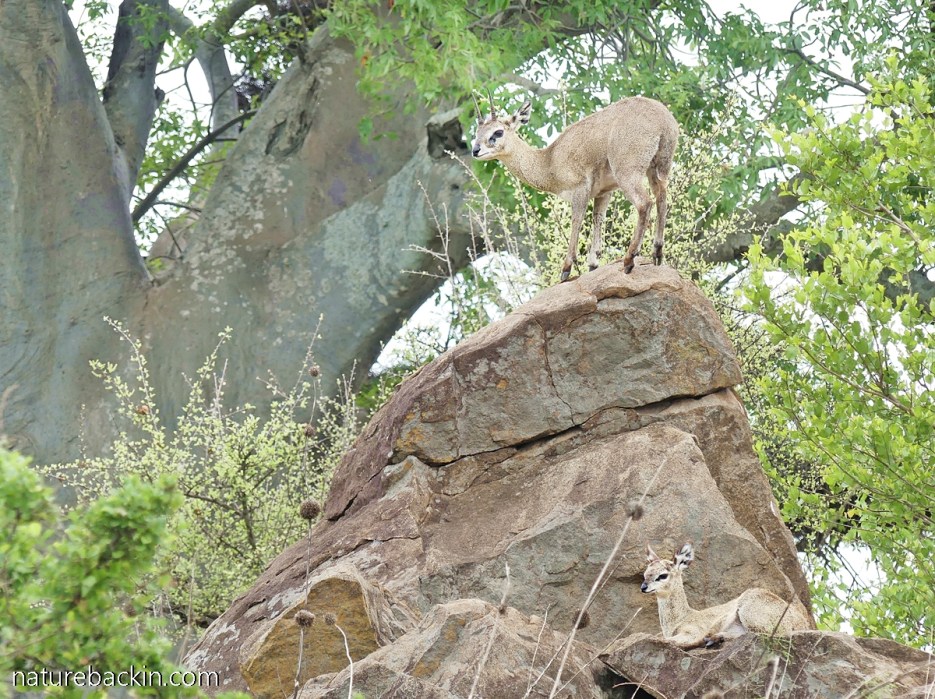
In another sighting of a male klipspringer on guard, we could see the female lying down and resting just below him (see above). In areas with high predation levels they may take turns standing guard giving the male a chance to forage. Klipspringer pairs are monogamous and remain in unusually close proximity to each other most of the time.
Like many other territorial antelope they maintain dung middens and both are involved in scent-marking their territory using their pre-orbital glands to leave small black deposits on sticks and twigs of vegetation, with the male doing most of the marking and also over-marking the female’s marks. The pair bond in klipspringers is also maintained by alarm-calling that is synchronised and protracted. Estes notes that this synchronised calling is possibly comparable to the duetting of pair-bonded birds (Estes 1993: 50). Their calling also advertises their presence to other klipspringers. While courting prior to mating the male makes a faint humming sound while following the female.
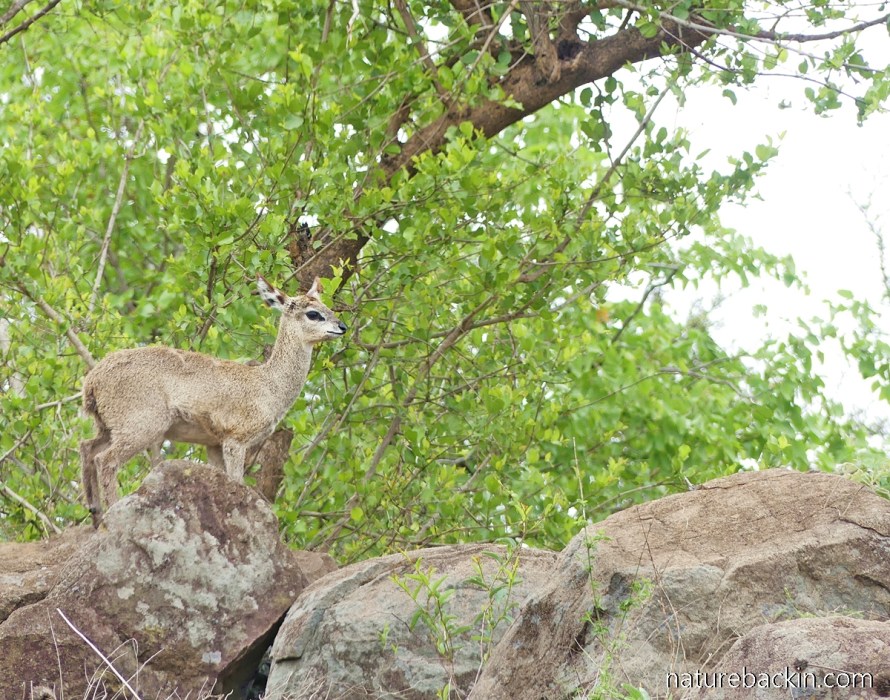
After spending quite some time lying down the female stood up revealing her rather chunky shape and powerful hindquarters, all the better to jump with. As in most dwarf antelope, the female is slightly heavier than the male. In southern Africa, female klipspringers do not have horns, but some females in some populations of klipspringers in East Africa do have horns.

Above is a closer view of the male showing the characteristic black patch of bare skin around the pre-orbital gland, which is more developed in males than in females. The specialised hooves with flattened tips are also visible. Klipspringers are very agile and surefooted and can bound up and down steep and quite smooth rock faces. They are also able to jump from rock to rock, landing on all four feet even where the surface area of a landing site is small.
A further interesting characteristic is that the hairs in a klipspringer’s rough fur are brittle and loose providing padding as they move around on and in between unforgiving rock surfaces and also providing excellent insulation against extremes of both heat and cold. As in many other antelope species, the hairs are hollow, i.e. air-filled, which also improves thermoregulation.

The third time we saw klipspringers in the park, the male was standing on top of the highest point of a rocky outcrop. A second klipspringer lying close by was a juvenile male with short and less developed horns. He is likely to be the offspring of the adult male and his mate, which we did not see. It is likely that she was out of sight on the other side of the outcrop.
Klipspringer offspring usually disperse when they are around a year old, with males tending to disperse a bit sooner than females. Sometimes daughters might stick around with the parents for a bit longer. There is some evidence that single males may form territorial defence coalitions with one or two other males.
By the way, common duiker, another species of small antelope that is frequently seen in the Kruger National Park, are in a completely separate tribe known as Cephalophini. The dwarf antelopes are members of the Neotragini tribe, part of the Antilopinae subfamily, which comprises also a second tribe known as Antilopini, which are the gazelles and their relatives.

For the dwarf antelopes the taxonomic plot thickens! Recent molecular analysis indicates that probably two of the seven genera in the Neotragini tribe are more likely unique (and older) lineages. One of these is the Oreotragus genus, which includes a single species, the klipspringer (Oreotragus oreotragus). The other is the Neotragus genus. Rather awkwardly given the naming, the tribe Neotragini may end up excluding the Neotragus genus (which includes three species – the only southern African species being the suni). But to mangle and misquote, a dwarf antelope by any other name is just as sweet.
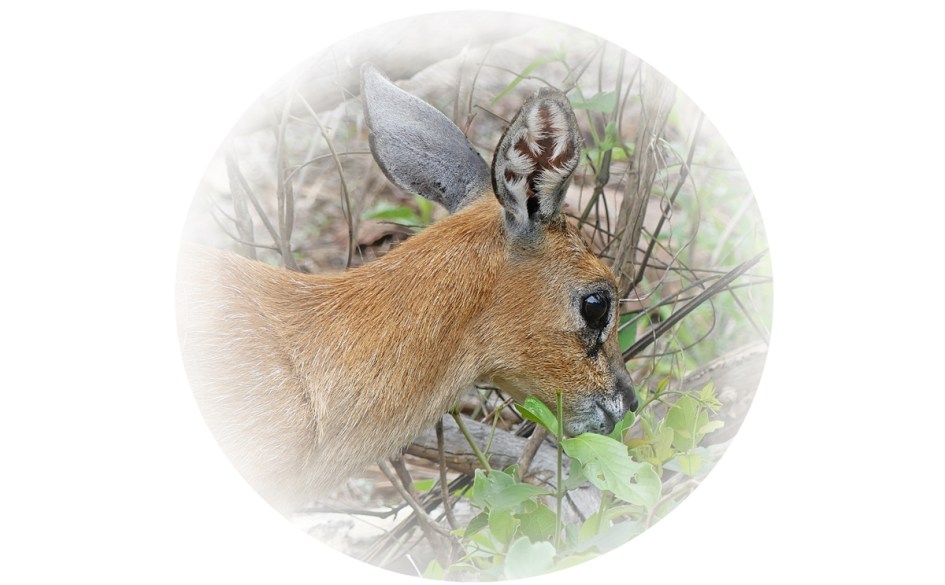
Sources
Estes, Richard. 1993. The Safari Companion a Guide to Watching African Mammals. Halfway House: Russel Friedman; Explorer Apps Ltd. 2021. ‘Rare, historical unsubstantiated records’ in KrugerExplorer. https://www.krugerexplorer.com/; Hocking, S. 2004. “Raphicerus sharpei” (On-line), Animal Diversity Web. https://animaldiversity.org/accounts/Raphicerus_sharpei/; Brent Huffman. 2016. Oreotragus oreotragus Klipspringer. http://www.ultimateungulate.com/Artiodactyla/Oreotragus_oreotragus.html; Brent Huffman. 2016. Raphicerus campestris Steenbok. http://www.ultimateungulate.com/Artiodactyla/Raphicerus_campestris.html; Brent Huffman. 2016. Subfamily Antilopinae. Gazelles, dwarf antelopes, and relatives. http://www.ultimateungulate.com/Artiodactyla/Antilopinae.html
Posted by Carol

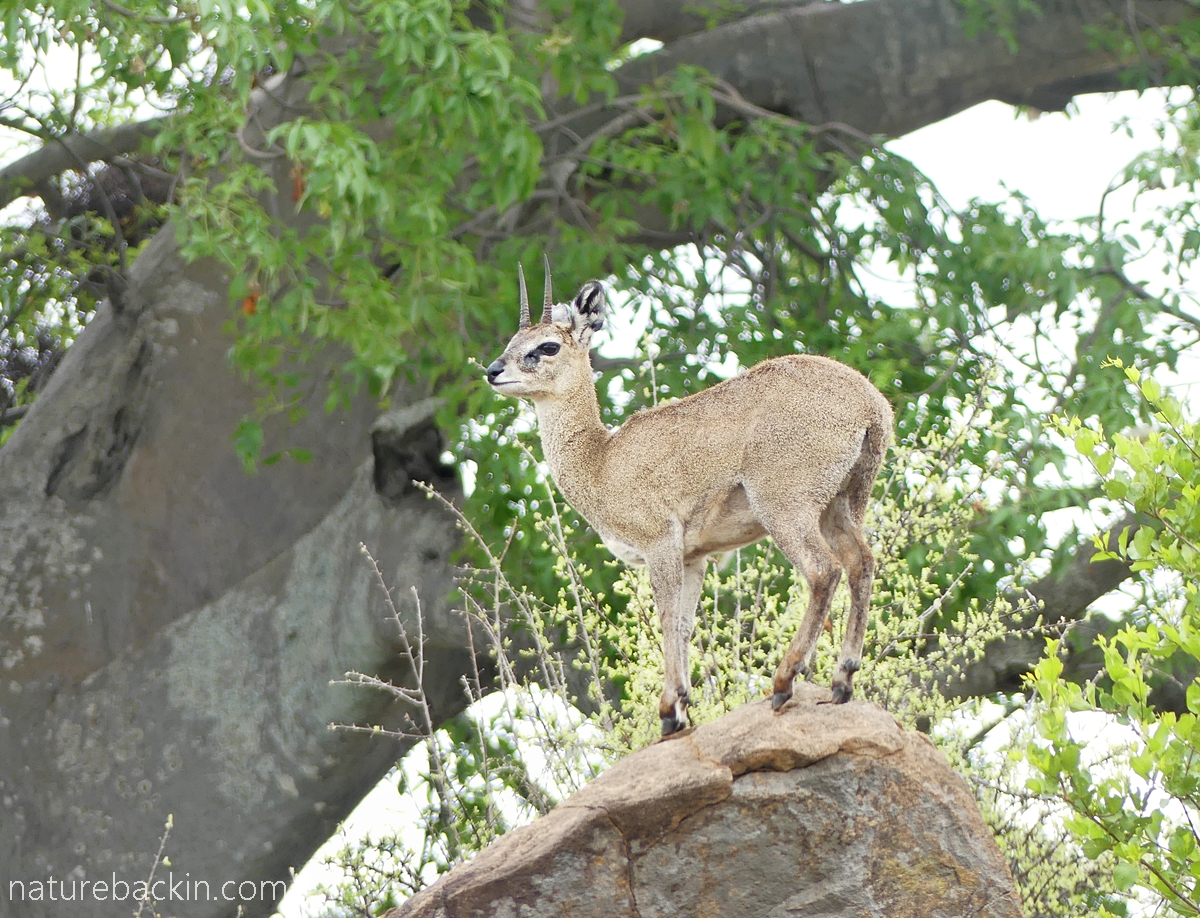







January 25, 2022 at 7:07 pm
These dwarf antelope are splendid and appear so fragile. So in the first paragraph the two dwarf antelope types have sadly gone extinct, making me wonder how many others are on the brink. I also wondered when the dwarf first appeared, how ancient are they? I’ve seen so little information on these animals, thank you for sharing the details of their lives and your great photos.
LikeLiked by 1 person
January 25, 2022 at 8:56 pm
Hi Laura – sorry to mislead you re the status of the suni and oribi antelopes. I was only indicating that they are absent from Kruger National Park, but they do occur elsewhere within their range in southern Africa (and elsewhere in Africa too). Their numbers are declining due to habitat loss and other factors but they are not listed as endangered, as far as I know. Regarding how ancient the lineages of these dwarf antelopes are, I gather they are quite ancient relative to some of the other antelopes. For more see http://www.ultimateungulate.com/Artiodactyla/Antilopinae.html
LikeLiked by 1 person
January 14, 2022 at 10:14 pm
Lovely, love post. Oh, those ears!! I just want to reach out and touch all of them. What precious animals they are. I’m so glad you got to see them up close.
-Julie
LikeLike
January 14, 2022 at 3:27 pm
I once again thoroughly enjoyed your essay, Carol, this one endearing us to these adorable dwarf antelope. I have had the pleasure of seeing two of these three species, and the fountain of information added greatly to my love for these beauties. I found the dung midden info fascinating, and you did a great job of describing the behavior. Your photos were tremendous. I can never get enough of those steenbok ears and klipspringer hooves. How fantastic that you saw so many klipspringers on this Kruger visit. They’re often so far away up in the rocky cliffs. And I was thrilled that you had time to enjoy the Sharpes Grysbok and share it with us. My warmest thanks.
LikeLiked by 1 person
January 14, 2022 at 5:21 pm
Hi Jet – Lovely to know that you have also had the pleasure of seeing some of the dwarf antelopes. The steenbok ears are their ‘crowning glory’ and the klipspringer hooves are such a remarkable adaptation. We were very lucky to see so many klipspringers and relatively close-by too. Being able to watch the grysbok being so unconcerned by our presence was a special experience and it was nice to be able to share it. Thanks! 🙂
LikeLiked by 1 person
January 10, 2022 at 4:03 am
Ah Carol thats so lovely. I learnt so much from this post. What beautiful little animals, I particularly love the grysbok. Well done on your patience and keen eye. Its so refreshing to read about animals that aren’t as popular and well known as the ‘big five’.
LikeLiked by 1 person
January 11, 2022 at 1:57 pm
Thanks Carol. The grysbok had a lovely delicacy. I think those motivated to see the ‘big five’ overlook and miss out on so much.
LikeLike
January 8, 2022 at 8:02 pm
Fascinating (as always!) It’s such a pleasure to be introduced to these charming little critters! I was aware that our pronghorns were not antelopes, but didn’t realize they were in a class all their own. Sad to say I’ve also noticed seeing less of them in our travels (as Tanya pointed out.)
Your antelope captures are beautiful. Those ears are quite elegant. But oh! those majestic poses on top of the rock cliffs. They are some amazing creatures for sure. May they thrive forever.
LikeLiked by 1 person
January 9, 2022 at 1:24 pm
It is sad that the pronghorns continue to be ‘displaced’ (what a euphemism!).
It is quite remarkable that tiny klipspringers can appear so majestic. Actually all three little antelopes have a lot of charisma. I am pleased to hear that you enjoyed meeting them! 🙂
LikeLiked by 1 person
January 8, 2022 at 6:18 am
Very interesting, Carol and great photos as always. How exciting to see these on your trip. You must have had a great time.
LikeLiked by 1 person
January 9, 2022 at 1:11 pm
Thanks Graham. Yes these small antelope are lovely to see. It’s a shame that so many visitors are more about seeing the ‘big five’. A few passing cars flagged us down asking if we’d seen anything exciting, with one driver even complaining about all the “bloody zebras”! Unfortunately for such visitors, they would not be very excited to see little antelopes.
LikeLiked by 1 person
January 10, 2022 at 6:21 am
I wouldn’t mind seeing some “bloody zebras.” I get a bit of the same reaction when people see me taking photos of bugs and the like!
LikeLiked by 1 person
January 11, 2022 at 2:00 pm
🙂
LikeLike
January 7, 2022 at 6:23 pm
Lovely photos of some beautiful creatures
LikeLike
January 7, 2022 at 8:21 pm
Thanks very much Denzil.
LikeLiked by 1 person
January 7, 2022 at 5:42 pm
Enchanting creatures. I suspect you spent hours waiting and watching to capture this remarkable set of photographs. Or was it just good luck?!
LikeLiked by 1 person
January 7, 2022 at 8:21 pm
Enchanting is a good word for these small antelope. Actually it was good luck – most of what we see is entirely serendipitous but we do tend to dally to make the most of what we see whatever it is, rather than driving long distances in the hopes of seeing more!
LikeLike
January 7, 2022 at 8:26 pm
Ah. Thank you for sharing your good luck and dalliances with us
LikeLiked by 1 person
January 9, 2022 at 12:54 pm
🙂
LikeLike
January 7, 2022 at 11:52 am
My first encounter with a duiker was just after WW2 when the whole family motored to a golf course on the South Coast near Scottsburgh. I must have been about 7 years old and we saw the duiker in a forrested area in the evening as we were leaving.The memory remains etched in my old brain so many years later.
LikeLiked by 1 person
January 7, 2022 at 8:17 pm
What a fantastic memory. I guess that would have been the incredibly tiny blue duiker that you saw?
I think seven is a particularly impressionable age and memories formed around that age are often particularly clear.
LikeLike
January 7, 2022 at 10:17 am
Such a wealth of fascinating information here. I have seen steenboks, klipspringers and duikers; they are all delightful little creatures.
LikeLiked by 1 person
January 7, 2022 at 8:15 pm
Yes they are – it is always a thrill to see them.
LikeLiked by 1 person
January 7, 2022 at 8:35 am
The whole time I was reading this, I was trying to come to terms with these antelopes’ diminutive size. I’m really struggling to imagine them living out their lives on the vast canvas that is their home.. Delightful creatures, all of them.
LikeLiked by 1 person
January 7, 2022 at 8:14 pm
I guess they have found their niche, but the lives of all wild animals seems quite precarious.
They really are delightful and so enchanting to see.
LikeLiked by 1 person
January 7, 2022 at 4:09 am
They really are sweet!
You had a lovely sighting of the grysbok, Carol. Mahonie Loop around Punda Maria is a good place to look for them – is this where you found her? Around Shingwedzi the S50, S52 and S56 are also usually good for us in terms of Grysbok encounters. We’ve even been lucky to find them at Nwanedzi and Timbavati at the southern end of their distribution range in previous years, but dipped on them this year (not surprising when the grass in standing high enough to hide a buffalo!)
LikeLiked by 1 person
January 7, 2022 at 8:11 pm
Yes we did see the grysbok on the Mahonie Loop.
We did not do much road travelling unless moving between camps, choosing to keep car travelling distances low and slow 🙂
LikeLike
January 7, 2022 at 4:03 am
What a wealth of information, thank you. Also such beautiful photos.
Many thanks. Long live the adventures. ♥️
LikeLiked by 1 person
January 7, 2022 at 8:08 pm
Thanks Debbie. Indeed – long live adventures!
xxx
LikeLike
January 7, 2022 at 4:00 am
What a fantastic experience to see a Sharpes Grysbok from such close quarters! Your photographs are lovely, Carol and I enjoy your narrative about each of these animals.
LikeLiked by 1 person
January 7, 2022 at 8:07 pm
Thanks Anne. It was particularly special to see the little grysbok so close up. It was also great to see the klipspringers as we don’t see them very often.
LikeLike
January 7, 2022 at 2:39 am
Absolutely delightful Carol, your keen observation, no doubt, enabled you to spot these beautiful little antelope in the bushveld. Thank you! xxx
LikeLiked by 1 person
January 7, 2022 at 8:05 pm
I think we miss far more than we see when visiting the bushveld, but it is is rewarding nonetheless!
xxx
LikeLiked by 1 person
January 6, 2022 at 11:29 pm
Thank you for introducing these pretty little antelopes. Incidentally, I get to see pronghorn relatively frequently, whenever I’m on the outskirts of town and in the countryside. Unfortunately, their numbers have been declining ever since the West was settled by European immigrants.
LikeLiked by 1 person
January 7, 2022 at 8:03 pm
How wonderful to be able to see pronghorns fairly often. They look fascinating. Sad that their numbers are still declining.
LikeLiked by 1 person
January 8, 2022 at 3:07 pm
Yes, very sad. What used to be their habitat continues to be turned into residential areas. Too many people on this planet. 😦
LikeLiked by 1 person
January 9, 2022 at 1:14 pm
A sad scenario across much of the world …
LikeLiked by 1 person
January 6, 2022 at 11:05 pm
Such tiny beasts! Though they sound tough and well-adapted to their habitat. I love the furry patterns in the ears. Wonderfully informative post, Carol!
LikeLike
January 7, 2022 at 7:59 pm
Thanks Eliza. Yes those ear patterns are unexpected and add to their charm.
They do seem to be well-adapted to their environment and have interesting survival strategies.
LikeLike
January 6, 2022 at 9:51 pm
Another fascinating post! Looks like your trip was one to remember for a lifetime! Love learning about all those creatures, but the dwarf antelope is my favorite. I just want to reach out and stroke those fabulous ears…. Wonderful photography, as always!
Regards,
Julie
LikeLiked by 1 person
January 7, 2022 at 7:55 pm
Thanks Julie. They are gorgeous little creatures and it is so lovely to see them.
I hope all is going well with you.
LikeLiked by 1 person